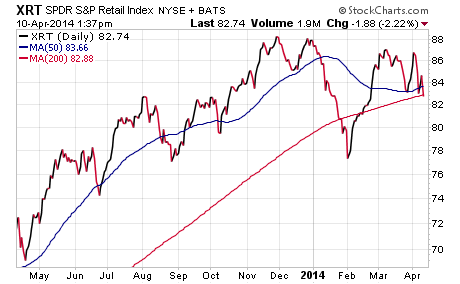Discretionary ETF Best SPDR For 3 Years Apple Inc (NASDAQ AAPL) Inc (NASDAQ AMZN)
Post on: 16 Март, 2015 No Comment

Since March 22, 2010, the SPDR S&P 500 (NYSE: SPY ) has returned 42 percent, including dividends paid. An impressive performance to be sure, but it is often said, and it is true, that sectors lead the broader market not the other way around.
On a related note, a frequently discussed topic in recent months has been what sectors are displaying leadership qualities. With consumer staples ranking high on that list. some investors, professional and retail, have doubted the viability of the broader market rally.
Interestingly, a case can be made that this has been a risk off rally for three years now. Using the nine Select Sector SPDRs as the barometers while going back to March 22, 2010, only one so-called risky ETF has offered noteworthy out-performance of those sector funds that are perceived to have less risk. That ETF is the Consumer Discretionary Select Sector SPDR (NYSE: XLY ).
The Consumer Discretionary Select Sector SPDR has returned 68.6 percent since March 22, 2010, meaning the ETF has been simply dominant over other sector funds such as the Materials Select Sector SPDR (NYSE: XLB ), the Financial Select Sector SPDR (NYSE: XLF ) and the Technology Select Sector SPDR (NYSE: XLK ).
XLY has easily trumped XLF and XLB over the past 24 months as well. Over that time, XLY has offered better than six times the returns of XLB and almost double the returns of XLK. Remember, XLK had the benefit of having Apple (NASDAQ: AAPL ) among its top holdings as that stock surged to astronomical heights.
Not High Beta
What may come as a surprise to some investors is that XLY is not extremely volatile despite being home to stocks that are believed to be intimate plays on consumer confidence and sentiment such as Amazon (NASDAQ: AMZN ), Home Depot (NYSE: HD ) and Walt Disney (NYSE: DIS ). The ETF has a beta of one against the S&P 500 and annualized volatility of 16.88 percent, according to State Street data .
That is a slightly lower beta than what is seen on XLK. Over the past three years, XLY has been about 500 basis points less volatile than XLB and the Energy Select Sector SPDR (NYSE: XLE ), according to ETF Replay data .
XLE and XLB currently have betas against the S&P 500 of 1.28 and 1.22, respectively.
Not The Only One
With $4.44 billion in assets under management, XLY is the largest discretionary ETF by that metric. It is home to plenty of familiar names and heavily traded with average daily volume of almost 5.5 million shares over the past three months.
However, XLY is not the only generator of noteworthy discretionary ETF returns over the past several years. With a three-year return of 67.6 percent, the Vanguard Consumer Discretionary ETF (NYSE: VCR ) stacks up favorably against the other non-discretionary sector ETFs mentioned here as well as Vanguard’s own lineup of sector funds.

While VCR and XLY are comparable on many levels, cost-conscious investors should keep an eye on this tussle in the coming months because a recent fee reduction by Vanguard means VCR is four basis points cheaper than XLY. That works out to 0.14 percent per year for VCR and 0.18 percent for XLY.
Investors that are willing to embrace some added risk can consider the First Trust Consumer Discretionary AlphaDEX Fund (NYSE: FXD ). Although FXD has lagged VCR and XLY over the past three years, but the First Trust offering has significantly outpaced other sector funds as well over that time, including energy, materials and technology.
FXD is not a market cap-weighted ETF. Rather, it uses growth and value metrics to parse through possible constituents. The result is an ETF that looks far different than VCR or XLY in terms of holdings. FXD holds 125 stocks with the top holding being Netflix (NASDAQ: NFLX ) at a weight of just 2.45 percent. Other top-10 holdings include Starz (NASDAQ: STRZA ) and Virgin Media (NASDAQ: VMED ).
FXD has been a decent performer over the past year with a gain of 12.2 percent, but some lower risk sector funds such as the Consumer Staples Select SPDR (NYSE: XLP ) have delivered better gains. FXD has a three-year standard deviation of 20.4 percent compared to 17.1 percent for the S&P 500 Consumer Discretionary Index, according to First Trust data .
That could be viewed as a sign that FXD is better suited to an environment that is more risk on friendly, but it is worth noting FXD has outpaced VCR and XLY year-to-date.
For more on ETFs, click here .
2015 Benzinga.com. Benzinga does not provide investment advice. All rights reserved.














